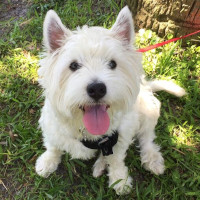Appearance of the Westie-Laso
|
| The Westie-Laso is a small dog, measuring less than 30.5 centimeters and weighing less than 9 kilos, with a long, straight coat that can come in a wide variety of colors thanks to its kinship with the Lhassa Apso, a short muzzle and often exaggerated eyebrows and whiskers. Despite their small size, many are strongly built, with surprisingly muscular legs and chest. They have round, dark, sparkling, inquisitive eyes, ears that can be pricked, tilted or folded, and a short to medium tail that often carries a little extra down. |
Temperament of the Westie-Laso
|
| On the whole, Westie-Lasos are considered to have a fairly strong temperament, but they are complex dogs that can often change mood quickly depending on the situation. At home and with the family, they're quite affectionate and playful, and can even become comical, especially with those they're comfortable with. But given their ancient hereditary functions as hunters and guardians, they can become very protective of food, toys and even their masters, and are often skeptical of strangers, whom they will greet with a plethora of barks. Because they can tend to be a little stubborn, training them as early as possible will help to ensure the best possible results in terms of overall behavior, although barking is often the last thing to be eliminated by training, if at all. If socialized from the outset, this breed can coexist with other pets in the home, but its protective and sometimes moody behavior can be a problem if not addressed. On the whole, Westie-Lasos don't need much exercise, but they do need a good dose of mental stimulation, and if they don't get enough, they can become destructive. |
Needs and activities of the Westie-Laso
|
| The Westie-Laso is not a particularly energetic dog, which makes it a good pet for people with limited living space, but it still needs 30 to 45 minutes of exercise a day and around 10 km of walking a week. More than anything, owners need to provide them with mental stimulation to prevent them from becoming bored, frustrated or even destructive. Spoiling toys, games that appeal to their problem-solving skills and creative play are all useful in keeping this breed happy and physically and mentally healthy, especially as they tend to focus on their hunting and guarding duties by barking profusely. |
Maintenance of the Westie-Laso
|
| Westie-Laso maintenance depends largely on the amount of Lhassa Apso hair it inherits. If it's a dog with a thick, long coat, you'll need to give it almost daily attention by combing and brushing to prevent it from tangling, matting or clogging. Many owners who are faced with more rigorous maintenance routines start their dog young to make the process easier and more comfortable later on, and/or take their dog to the groomer regularly to keep his coat shorter and easier to maintain, which doesn't exempt them from doing daily routines at home or taking a bath every two weeks. For those who own a dog with a coat closer to that of the West Highland White Terrier, maintenance is a little easier. Although they don't shed frequently, they will still need to be brushed, but more likely weekly than daily. They also need regular trimming of feet, ears and eyes to keep them clean and comfortable. Regardless of their coat, Westie-Laso teeth need to be closely monitored and regularly brushed whenever possible, as their brachycephalic facial structure is prone to dental problems. As with any other breed, toenails also need to be monitored and trimmed to prevent splitting and breaking. |









 English (United Kingdom)
English (United Kingdom)